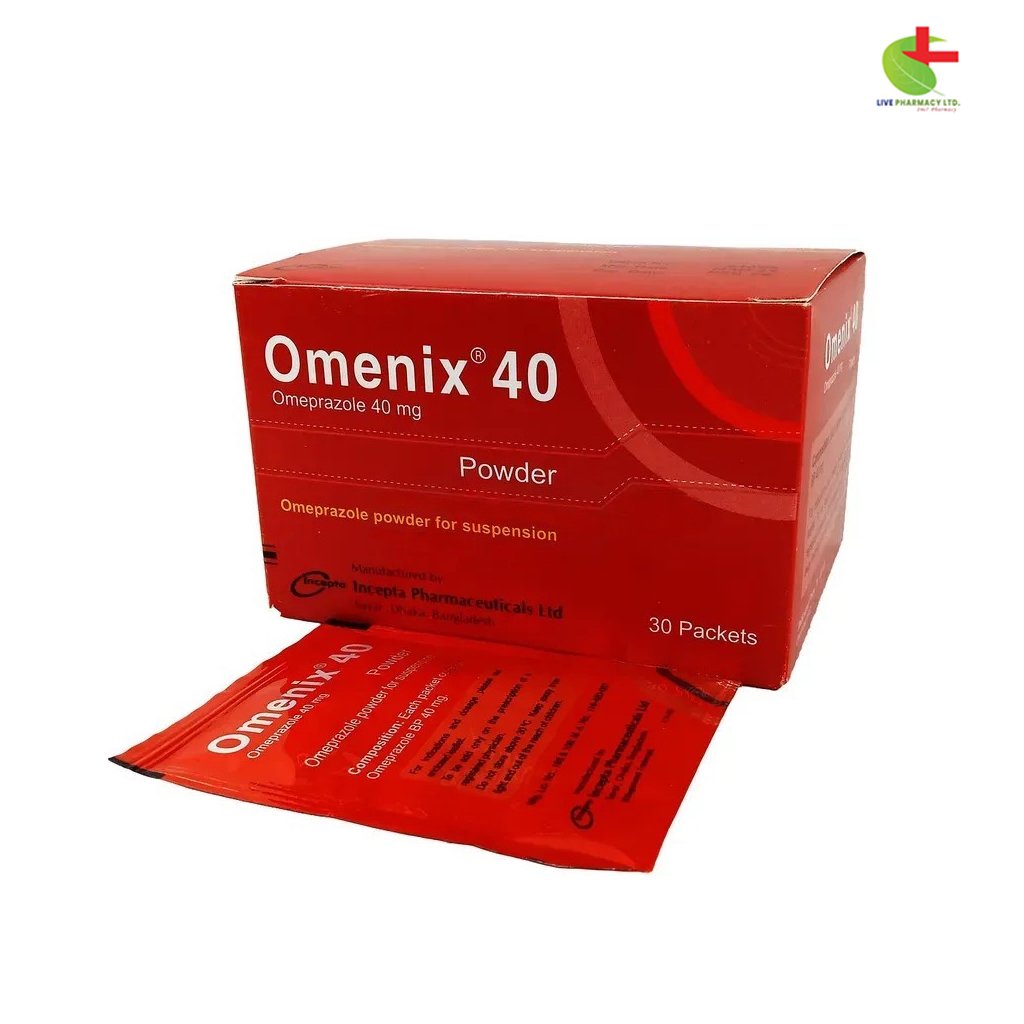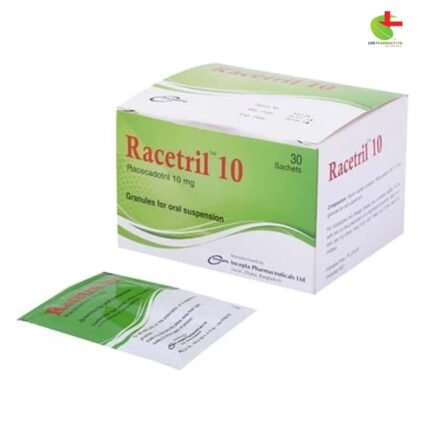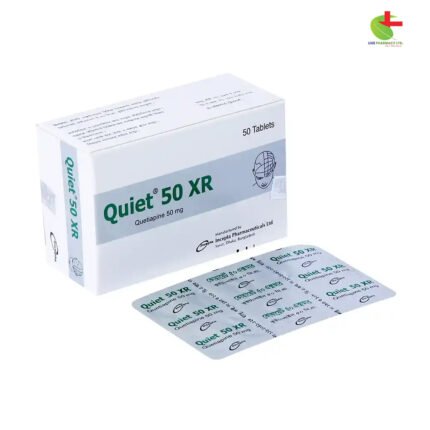Omenix 40
300.00৳ Pack (1*30)
- Omenix is a proton pump inhibitor indicated for treating gastric and duodenal ulcers, NSAID-associated ulcers, gastro-esophageal reflux disease, and Zollinger-Ellison syndrome.
- It works by inhibiting gastric acid secretion through the H+/K+ ATPase enzyme system.
- Available in oral and IV formulations, it provides effective relief from acid-related conditions with a fast onset of action.
- Side effects are generally mild and reversible, with precautions advised for certain patient populations.
 Brand
Brand
|
Incepta Pharmaceuticals Ltd |
|---|---|
 Generics
Generics
|
Omeprazole |
 Type
Type
|
Oral Powder |
Indications
Omenix is indicated for the management of the following conditions:
- Gastric and duodenal ulcers
- Duodenal and gastric ulcers associated with NSAID use
- Preventive treatment in patients with a history of NSAID-related duodenal and gastric ulcers
- Gastroesophageal reflux disease (GERD)
- Long-term management of acid reflux
- Acid-related dyspepsia
- Severe ulcerative reflux esophagitis
- Prevention of acid aspiration during general anesthesia
- Zollinger-Ellison syndrome
- Peptic ulcers caused by Helicobacter pylori infection
Consult a registered physician before using this medication.
Pharmacology
Omenix contains Omeprazole, a substituted benzimidazole that acts as a potent inhibitor of gastric acid secretion. It works by blocking the hydrogen-potassium-adenosine triphosphatase (H+/K+ ATPase) enzyme system in gastric parietal cells. After oral administration, the antisecretory effect begins within one hour, peaks within two hours, and can last up to 72 hours. Upon discontinuation, gastric acid secretion gradually resumes over 3 to 5 days.
Dosage Guidelines
Oral Administration:
- Benign Gastric and Duodenal Ulcers: 20 mg once daily for 4 weeks for duodenal ulcers and 8 weeks for gastric ulcers. In severe or recurrent cases, the dose may be increased to 40 mg daily. For maintenance, 20 mg daily is recommended.
- NSAID-Associated Ulcers: 20 mg daily for 4 weeks, with an additional 4 weeks if healing is not complete. For prevention, use 20 mg daily in patients with a history of NSAID-associated ulcers.
- Gastroesophageal Reflux Disease: Start with 20 mg daily for 4 weeks, extending to 4-8 weeks if necessary. For refractory cases, 40 mg once daily for up to 8 weeks may be prescribed, with a maintenance dose of 20 mg daily.
- Long-Term Acid Reflux Management: 10-20 mg daily.
- Acid-Related Dyspepsia: 10-20 mg daily for 2-4 weeks.
- Prevention of Acid Aspiration: 40 mg the evening before surgery and 40 mg 2-6 hours prior to the procedure.
- Zollinger-Ellison Syndrome: Initiate with 60 mg daily, with a typical range of 20-120 mg daily, divided if exceeding 80 mg.
- Helicobacter Pylori Eradication: Administer 20 mg twice daily with antimicrobial agents such as Amoxicillin and Metronidazole or Clarithromycin.
- Pediatric Use (Child >1 year): Dosage varies by weight, with 10-20 mg daily for children weighing 10-20 kg and 20-40 mg for those over 20 kg for 4-12 weeks.
IV Injection:
- Acid Aspiration Prevention: Administer 40 mg intravenously one hour before surgery.
- Ulcer Treatment: In cases where oral medication is not suitable, administer 40 mg IV once daily for duodenal or gastric ulcers and reflux esophagitis.
- Zollinger-Ellison Syndrome: Start with 60 mg IV daily, adjusting doses individually as needed. Doses over 60 mg should be given in two divided doses.
Consult a registered physician before using this medication.
Administration Instructions
IV Injection: Omeprazole should be reconstituted with 10 ml of water for injection and administered slowly over 2 to 5 minutes at a maximum rate of 4 ml/minute. Use only freshly prepared solutions within 4 hours of reconstitution.
IV Infusion: Dissolve the contents of one vial in 100 ml saline or 5% dextrose for infusion. Administer over 20-30 minutes. Use saline solutions within 12 hours and dextrose solutions within 6 hours of preparation. Do not mix with other medications in the same infusion set.
Consult a registered physician before using this medication.
Drug Interactions
Omenix may reduce the absorption of ketoconazole and can impact the metabolism of diazepam, phenytoin, and warfarin. Patients on these medications should be monitored closely, and dose adjustments may be required. Concurrent use of Omenix with clarithromycin can increase plasma concentrations, which is beneficial for H. pylori eradication. There are no known interactions with various other drugs, including phenacetin and theophylline. Alcohol and food do not affect Omenix absorption.
Contraindications
Omenix is contraindicated for individuals with known hypersensitivity to Omeprazole. If a gastric ulcer is suspected, malignancy must be ruled out before starting treatment, as it may mask symptoms.
Side Effects
Omenix is generally well-tolerated, with mild and reversible adverse reactions. Common side effects may include skin rash, urticaria, and pruritus, usually resolving upon discontinuation. Other reported effects include diarrhea, headache, constipation, nausea, abdominal pain, and dry mouth. Rarely, more serious effects such as blurred vision, psychiatric symptoms, and liver enzyme increases have been noted.
Pregnancy & Lactation
Omeprazole has not shown adverse effects on pregnancy or fetal health in three epidemiological studies, making it safe for use during pregnancy. However, its effects on breastfeeding are unknown, and discontinuation may be necessary if Omeprazole is deemed essential.
Use in Children & Adolescents
The safety and effectiveness of Omeprazole have not been established in patients under 18 years of age.
Precautions & Warnings
Avoid using Omenix in conjunction with clopidogrel, as it may diminish clopidogrel’s effectiveness. Long-term PPI therapy has been associated with an increased risk of osteoporosis-related fractures. Monitor for signs of atrophic gastritis in patients on long-term treatment. Concomitant use of PPIs with methotrexate may increase the risk of toxicities.
Therapeutic Class
Proton Pump Inhibitor
Storage Conditions
Store in a cool, dry place, away from light and heat. Keep out of reach of children.













Reviews
There are no reviews yet.